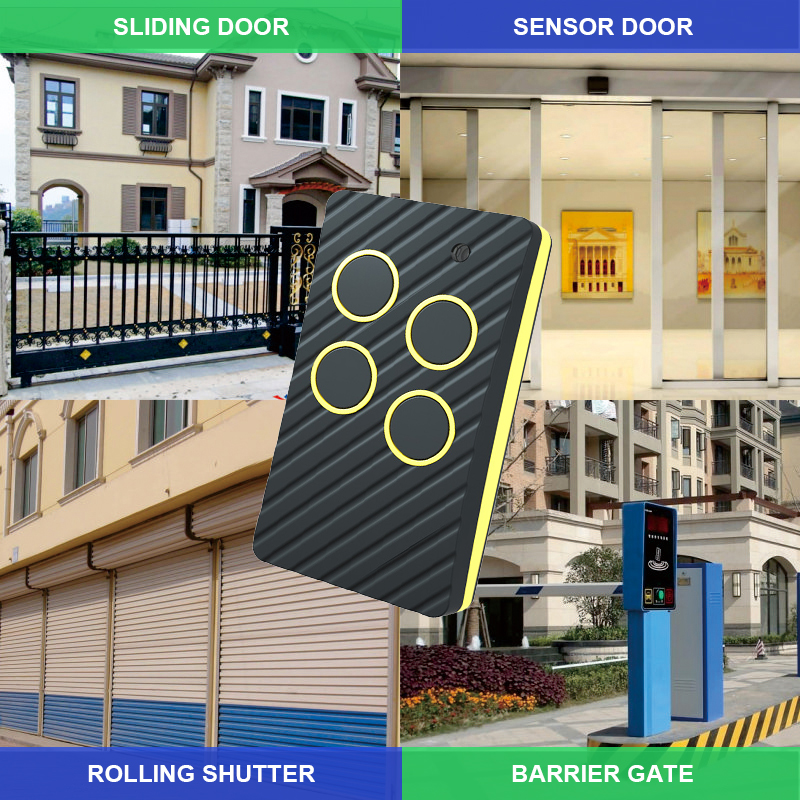When working with gate openers, the operating frequency of your remote control is a critical component. It determines the communication between the remote and the receiver. But what if the frequency of your current remote doesn’t match your system, or you’re building a custom gate remote? Can you change the frequency? The short answer is yes, but with limitations and considerations. Let’s dive into the details.

Understanding Frequency in Gate Remote Controls
Gate remote controls communicate with gate openers using radio frequencies (RF). Common frequencies include:
315 MHz and 433 MHz: Widely used in Europe, Asia, and the Americas.
868 MHz: Often seen in modern European systems for better security and reduced interference.
Other less common frequencies depending on the manufacturer and region.
Why Does Frequency Matter?
Compatibility: The remote and receiver must operate on the same frequency to communicate.
Regulations: Frequencies are regulated by authorities like the FCC in the U.S. or ETSI in Europe to avoid interference with other devices.
Signal Strength and Range: Lower frequencies typically have better range but may be more susceptible to interference, while higher frequencies can offer more channels and less congestion.
Is It Possible to Change the Frequency?
Yes, you can change the frequency of your custom gate remote control, but the process depends on whether you’re modifying an existing remote or designing one from scratch.
Modifying an Existing Remote
Most standard remotes are built to operate on a fixed frequency. Changing their frequency often requires hardware modifications:
Replace the RF Module:
Open the remote’s casing and locate the RF module.
Swap it for a module that operates on the desired frequency.
Retune the Crystal Oscillator:
Some remotes use a crystal oscillator to set their frequency. Replacing the crystal with one that supports the target frequency may work.
This requires precise tools and expertise to avoid damaging the circuitry.
Designing a Custom Remote
If you’re building a remote from scratch, selecting and programming the frequency is straightforward:
Choose the Right RF Module:
Select a transmitter module compatible with the desired frequency (e.g., 315 MHz, 433 MHz, or 868 MHz).
Ensure the module complies with local regulations.
Program the Microcontroller:
Use a microcontroller like Arduino or ESP32 to configure the RF module to operate at the desired frequency.
Include code for encoding and signal transmission.
Considerations When Changing Frequency
1. Legal Compliance
Ensure the new frequency is allowed for use in your country. Unauthorized frequencies can interfere with other devices or breach regulations.
Check local rules from organizations like the FCC, ETSI, or ACMA.
2. Receiver Compatibility
Changing your remote’s frequency requires the gate receiver to match the new frequency. If the receiver is fixed, you may need to replace or modify it as well.
3. Security Protocols
Changing the frequency doesn’t alter the coding system (e.g., fixed or rolling codes). Ensure the encoding method remains compatible with the receiver.
4. Hardware Constraints
Some remote designs are hardwired to specific frequencies, making modification impractical or impossible without significant rebuilding.
Steps to Change Frequency in a Custom Remote
Determine the Current Frequency:
Use a frequency scanner to detect the remote’s transmission frequency.
Select a New RF Module:
Pick a module that supports your desired frequency and has good range and signal reliability.
Reprogram Your Remote:
Adjust the microcontroller code to accommodate the new module’s frequency.
Test the remote with the receiver to ensure smooth operation.
Update the Receiver (If Necessary):
Replace or reprogram the receiver module to match the new frequency.
Test for Functionality and Compliance:
Check that the new setup works reliably without interference.
Ensure it adheres to local RF regulations.
Challenges of Changing Frequency
Signal Interference: Switching to a crowded frequency band may reduce performance.
Hardware Limitations: Pre-built remotes may not support hardware changes without advanced skills.
Cost: Replacing modules or receivers can add to project expenses.
Alternatives to Changing Frequency
If modifying your remote’s frequency seems too complex, consider these alternatives:
Universal Remotes: Many universal remotes support multiple frequencies and can be programmed to match your system.
Smart Controllers: Upgrade to a Wi-Fi or Bluetooth module to bypass traditional RF frequencies.
Professional Help: Consult a technician for hardware adjustments or to find compatible equipment.
Conclusion
Changing the frequency of your custom gate remote control is possible but requires a mix of technical skills, proper tools, and a clear understanding of RF technology and regulations. For hobbyists and tech-savvy individuals, it can be a fun and rewarding challenge. However, for those seeking convenience, exploring universal remotes or professional solutions might be more practical.
Whether you’re modifying an existing device or building a custom one from scratch, the key to success is careful planning and adherence to both technical and regulatory requirements.

-
Office ViewQinuo Electronics Co., Ltd.was founded in 2009,it is a high-tech company that integrated R & D, manufacturing, sales and service for 15 years,which is mainly specialized in providing sensors of automatic door, control system of door and gate, car key remote, auto parts etc. The company currently has four independent brands: U-CONTROL, U-SENSORS, U-AUTOGATES and U-AUTOKEYS.
-
got questions? call us
+86 13960286508
-
fax :
+86 595 22901208 -
Email :
[email protected]
-
address
- No.991 Xingxiu Road,Taiwanese Investment Zone, Quanzhou, Fujian Province,P.R.China











